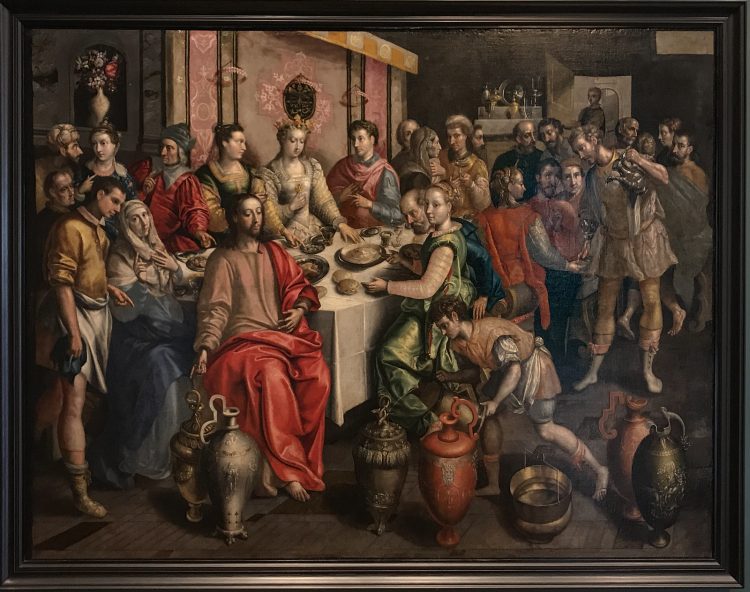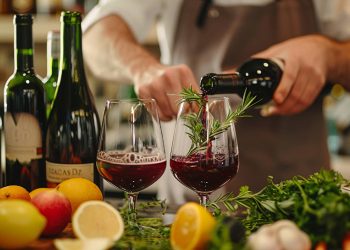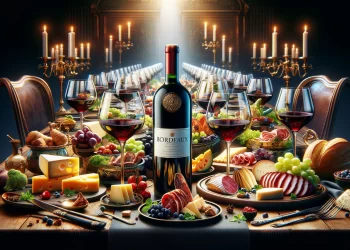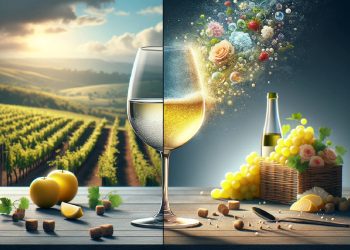The marvelous painting and and a marvelous historical scene
“Wine is constant proof that God loves us and loves to see us happy.” – Benjamin Franklin
Imagine a wedding in Cana, a scene brimming with anticipation, the aroma of unleavened bread mingling with the chatter of guests. It’s a celebration that could rival the grandest feasts of antiquity. Yet, in an unforeseen twist, the wine depletes. A figure reminiscent of Dionysus, Jesus turns water into wine in a spectacle that would leave even the gods of old in awe.
But let’s focus on Maarten de Vos’s 1596-1597 masterpiece, “The Marriage at Cana.” It’s not just a painting; it’s a freaking time machine to a world where the divine crashes the human party. Every stroke of the brush tells a story, each face in the crowd a testament to the bewilderment of witnessing a miracle.
So, my friends, as we journey through these pages, let us raise our glasses to the authors, the sommeliers, the vintners, and the storytellers. In their words, we find the essence of wine – a blend of art, science, and passion. Let’s immerse ourselves in the profound knowledge that accompanies wine’s fellowship.
“Jesus turns water into wine” is it real?
Encyclopedia Wines has the answer to this age-old question. Depending on who you ask, several interpretations of the Bible suggest Jesus Christ changed water into wine at a wedding in Cana. In John 2:1–11, it is written that when Jesus and his disciples attended a wedding feast where the wine had run out, he miraculously filled six stone jars with water and transformed them into fine wine.
![]()
Some debate whether or not this was an actual miracle or if Jesus simply revealed some hidden reserves of excellent quality wine that were already present at the location. We may never know the exact answer, but Encyclopedia Wines will help you unlock your own interpretation through our guidance and resources! Whether you’re looking for answers to questions about the history of wine, tips on how to store and serve it properly, or even just a good bottle for your upcoming event, we have something for everyone. Explore our site to learn more!
The symbolism of Cana’s miracle
The Cana miracle is often perceived as a testament to Jesus’ miraculous powers and a symbol of divine providence. It represents the transformation of the ordinary into the extraordinary, a reminder of God’s omnipresence and benevolence. This event also resonates with the Eucharist, where wine becomes a sacred symbol of Jesus’ presence.
Jesus turns water into wine at Cana but why?
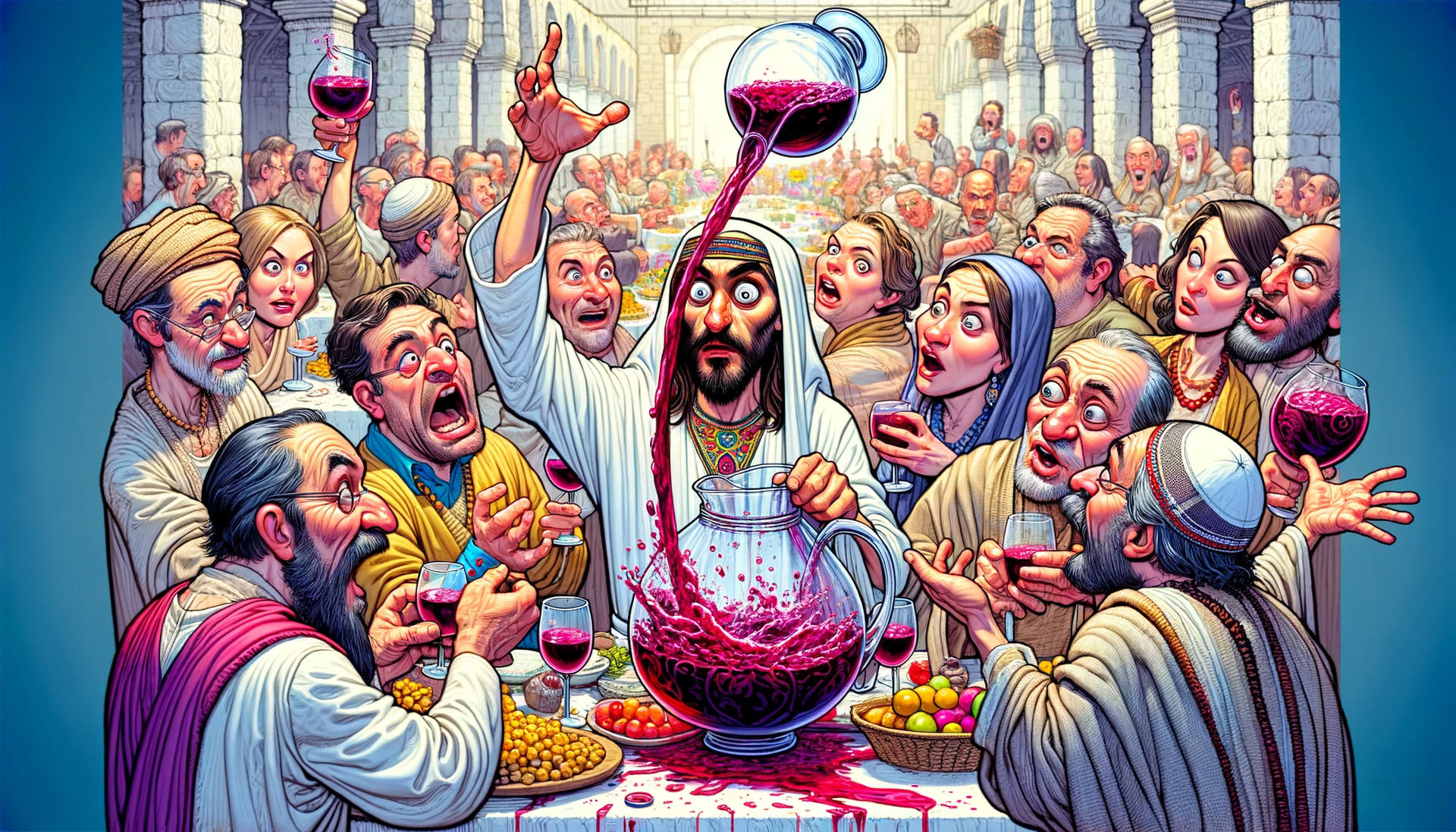
“The Marriage at Cana,” created by Maarten de Vos in 1596-1597
De Vos’s canvas is a smorgasbord of symbolism and hidden meanings. It’s like Where’s Waldo, but with Biblical characters and 16th-century fashion. The colors, oh the colors! They’re not just splashes of paint; they represent the very essence of transformation – from the mundane to the mystical, from water to wine.The guests in the painting?
The Marriage at Cana is a prime example of superior craftsmanship and exceptional standards, showcasing rich, vivid hues and meticulous attention to intricate elements that have garnered it widespread admiration for almost four centuries. If you are seeking an engaging topic of discussion or derive pleasure from appreciating exceptional artwork, this enduring masterpiece is certain to captivate you with its eternal allure. If you taste exquisite wines and art, The Marriage at Cana by Maarten de Vos is ideal!
What is the wedding at Cana painting about?
The Wedding at Cana is a painting by Dutch artist Marten de Vos that depicts the miraculous transformation of water into wine performed by Jesus during a wedding feast in Cana of Galilee. It is believed to be the first miracle of Jesus and symbolizes the abundance and joy that come from faith in Him.
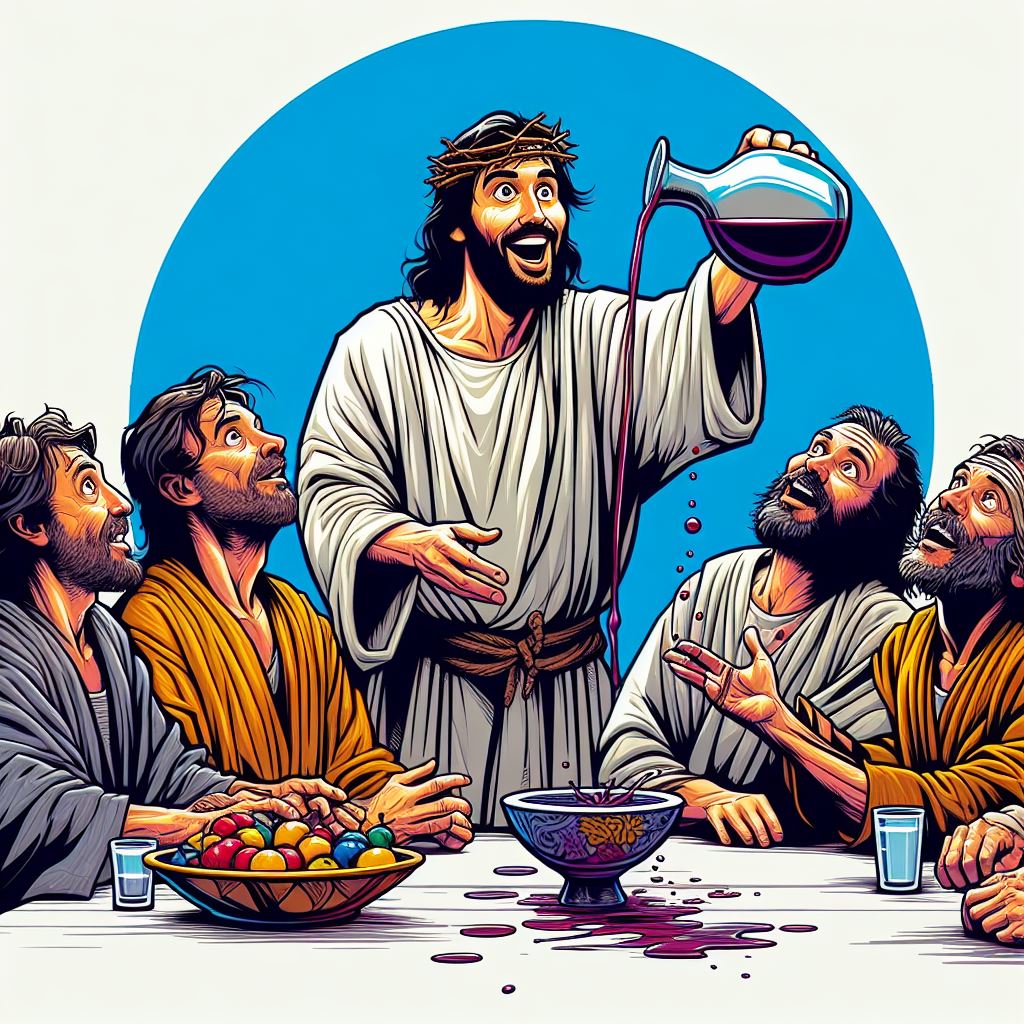
De Vos captures this moment with vibrant colors and exquisite attention to detail. The figures in the painting are depicted enjoying themselves amidst their family and friends, with reverence for God’s presence among them. The master of the feast is shown tasting the wine, astonished by its quality. This serves as a reminder that even in the midst of difficulty or uncertainty, we can find joy and fulfillment when we put our trust in God.
The Wedding at Cana is a powerful reminder of the importance of faith in our lives. It is also a beautiful work of art that celebrates the joy of marriage and the abundance of God’s grace.
- The wine in the painting is likely to be a red wine, as this was the most common type of wine in the region and time period.
- The jars used to hold the water are likely to be made of stone or clay.
- The painting is likely to be set in a large, open courtyard, as this was the traditional setting for wedding feasts in the ancient world.
The painting is also significant for its symbolism. The water represents the natural world, while the wine represents the spiritual world. The transformation of water into wine is a symbol of the transformation that takes place when we come to faith in Jesus.
The Wedding at Cana is a complex and multifaceted painting that offers a rich feast for the eyes, the mind, and the soul. It is a reminder of the importance of faith, the joy of marriage, and the abundance of God’s grace.
The wedding at Cana: A feast of faith, history, and wine
Think of the painting as a map, not a tracing. It’s not just depicting a Biblical tale; it’s an intertwining of stories, cultures, and interpretations. Like a vineyard with roots spreading in every direction, the painting invites us to explore connections – between art, religion, history, and yes, our own existence.
Artistically, it’s like De Vos threw a party and invited Nietzsche, Socrates, and Foucault. They’re all there, sipping on metaphysical Merlot, debating the essence of miracles and the human condition.
Really? What happened at the wedding in Cana?
The Wedding at Cana, as depicted in the Gospel of John, is rich in theological and symbolic meanings. Scholars often interpret this event through various lenses:
- Sign of the New Covenant: The transformation of water into wine is seen as symbolic of the new covenant in Jesus Christ, replacing the old Jewish rituals (symbolized by water) with the new wine of the Gospel.
- Eschatological Symbolism: Some theologians view the miracle as a foretaste of the eschatological feast, where Jesus, as the bridegroom, invites humanity to partake in the divine celebration.
- Manifestation of Divine Glory: This event is also seen as a theophany, where Jesus reveals his divine nature. The miracle at Cana is often interpreted as a sign of Jesus’ authority over nature and his ability to bring about transformation.
- Mary’s Intercessory Role: The interaction between Jesus and Mary at Cana has been a subject of theological discussion, highlighting Mary’s role as an intercessor and her deep faith in Jesus’ mission.
- Artistic Interpretations: Artists like Marten de Vos have captured this event, emphasizing various elements such as the divine aura around Jesus, the astonishment of the guests, and the abundance of wine, symbolizing God’s generosity.
- Sociocultural Context: Historically, the setting of a wedding feast in Cana reflects the social and cultural norms of the time, providing insights into Jewish matrimonial customs and community celebrations.
The Wedding at Cana is a multifaceted event that continues to inspire theological, artistic, and historical explorations, each offering a unique perspective on this miraculous occurrence.
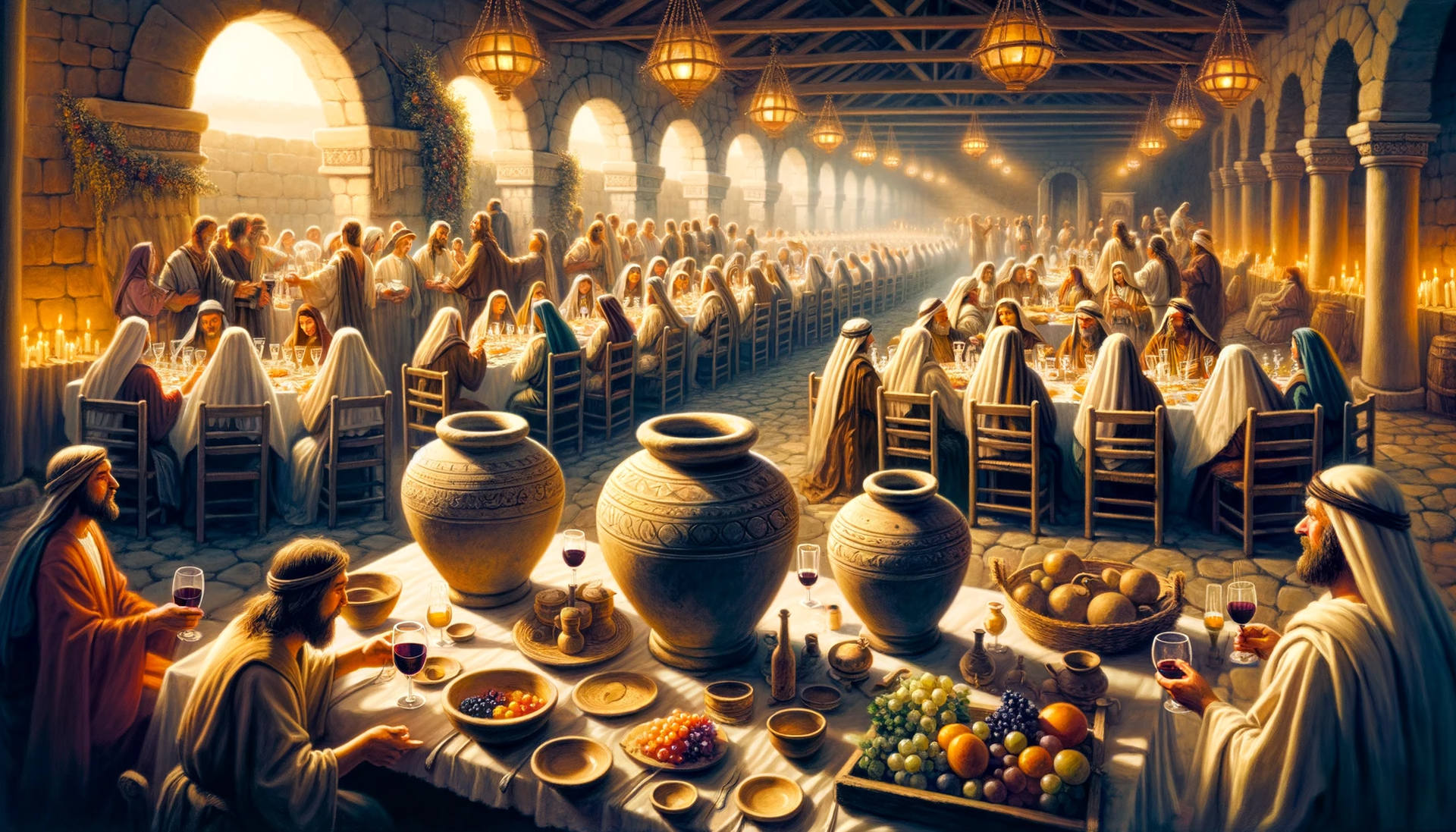
What is the main message of the wedding at Cana?
From canvas to context: a little analysis on “The Marriage at Cana”
“In vino veritas – In wine, there is truth.” – Pliny the Elder
Let’s pour ourselves into the subject of wine itself. This isn’t just fermented grape juice; it’s a libation of history, culture, and science. Each drop is a story – from ancient vineyards to modern-day sommeliers. Wine is not just about tasting notes; it’s about the notes of human history. And this miracle at Cana? It’s not just a party trick. It’s a narrative on transformation, a philosophical pondering on the essence of change. Water into wine – it’s like turning the mundane Monday into a freakin’ Friday night.
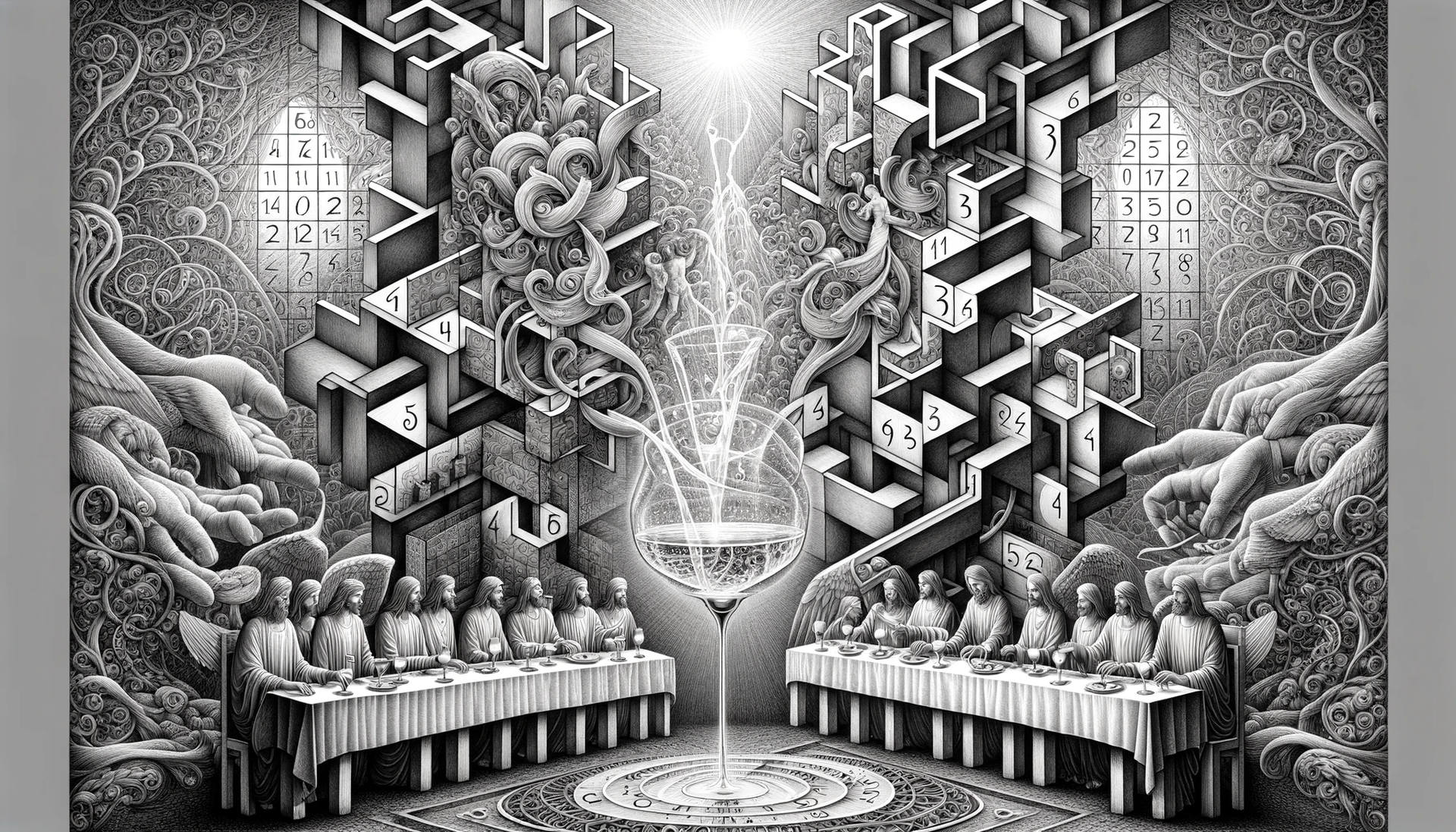
The alchemy of wine: More than just fermented gapes
Let’s dive headfirst into the world of wine, a realm where each drop isn’t just fermented grape juice but a swirling vortex of history, culture, and science. This isn’t your run-of-the-mill booze; it’s a libation steeped in stories, a narrative cocktail from ancient vineyards to the lips of modern-day sommeliers. Wine isn’t just about the symphony of tasting notes; it’s an odyssey through the annals of human history.
The Cana conundrum: A Philosophical Pondering
Aesthetics and Ethics: A Dance of Contradictions
Absurd and Leap of Faith: Embracing Paradox
The Individual and the Divine: Confronting the Self
The Role of Mary: A Reflection of the Feminine Divine
What does the Bible say about the wedding in Cana?
In John 2:1–11, the Bible tells us of a wedding in Cana. The wine runs dry, and Jesus is asked to intervene – and intervene, he does. Jesus turns water into wine, providing guests with an abundant supply of the good stuff. It’s symbolic of Christ’s power, his ability to make something out of nothing and, ultimately, a miracle that demonstrates the divine presence around us all.
What other stories are associated with the wedding at Cana?
The wedding at Cana is referenced throughout history, including in works of literature and art. Shakespeare wrote about it in The Merchant of Venice, while French painter Georges de La Tour depicted the moment in his painting “The Marriage Feast at Cana”. Artists have been inspired by its symbolism ever since. As such, it’s become a powerful parable for many who look to Jesus and the miracles he performed as evidence of a higher power at work.
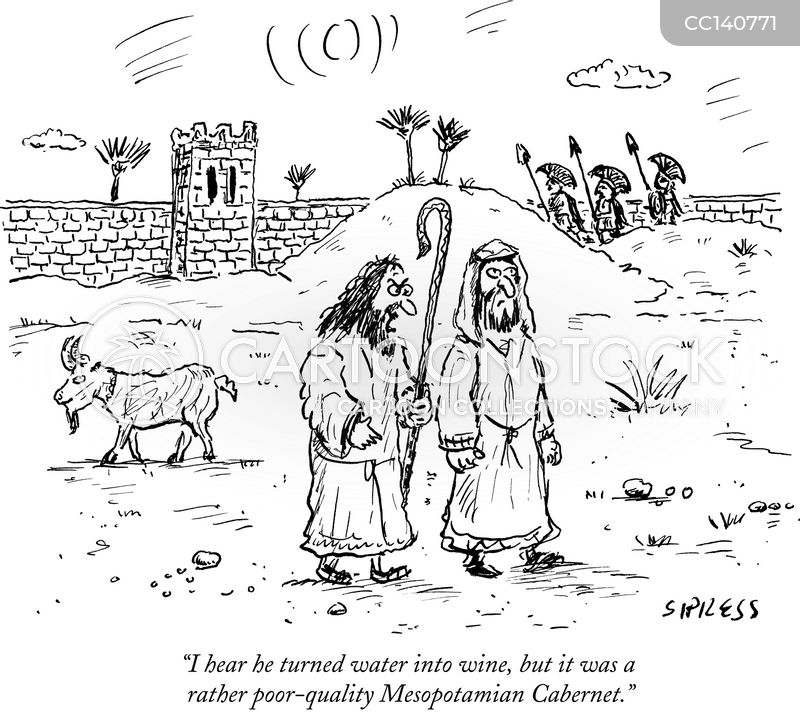
- Crosswalk.com – 3 Important Lessons from the Wedding at Cana: This article discusses the significance of the Wedding at Cana as the first miraculous sign given by Jesus, emphasizing its importance in Christian faith. Crosswalk.com
- Catholic Exchange – How the Wedding at Cana Retells the Story of Eden: This piece explores the connection between the Wedding at Cana and the story of Eden, drawing parallels between Mary’s role and the beginning of Jesus’ public ministry. Catholic Exchange
- The Church of Jesus Christ of Latter-day Saints – Chapter 12: The Wedding in Cana: This narrative recounts the story of Jesus Christ and His disciples attending a wedding feast in Cana, highlighting Mary’s role in the event. Church of Jesus Christ
- Learn Religions – The Wedding at Cana Details Jesus’ First Miracle: This summary provides an overview of the Wedding at Cana, where Jesus of Nazareth performed his first miracle, emphasizing its significance in the New Testament. Learn Religions
- Mission Bible Class – Wedding at Cana: This resource offers a detailed account of the Wedding at Cana story, focusing on Jesus, his disciples, and Mary’s involvement in the miracle. Mission Bible Class
- University of the Incarnate Word – Wedding at Cana Reflections: This reflection discusses the symbolic resemblance between the vows made by spouses at a wedding and God’s covenant with humanity, as illustrated in the Wedding at Cana miracle. UIW Reflections
- St. Peter’s McKinney – The Great Stories: The Miracle at the Wedding in Cana: This piece delves into the story of the marriage at Cana, highlighting how Jesus’ actions at the wedding demonstrate his ability to abundantly bless those who follow his guidance. St. Peter’s McKinney
- Bible Study Tools – Jesus Turns Water into Wine: This narrative recounts the story of Mary asking Jesus to help at a wedding that had run out of wine, leading to his first miracle. Bible Study Tools
Each of these examples showcases the diverse ways in which the story of the Wedding at Cana has been interpreted and its enduring impact across different mediums and interpretations.
What does wine symbolize?
Wine has long been a symbol of transformation – not just physical change but inner transformation too. Think you witness Jesus turns water into wine scene and his potential being realized, or possibility becoming reality. It’s a representation of how life can transform before our eyes if we’re willing to let it. Wine also stands for fertility, abundance, and joy, central to most cultures. Whatever its symbolism, it is clear that wine has been a part of our lives for centuries and will continue to be so in the future.
The Historical Context: A Rich Tapestry of Tales
Though we know little else about this ancient wedding feast beyond its Biblical reference, historians have picked apart every character and detail to uncover a wealth of narrative possibilities. Who were? What does the good book say about the wedding in Canada?
What does the wine symbolize in Cana’s wedding?
The wine at Cana’s wedding is not just a beverage; a symbol of joy and celebration. It was said that when Jesus changed the water to wine, it was the best quality of wine that had ever been made – so much so that it even impressed the steward, who had tasted all sorts of wines (John 2:10). This symbolizes God’s abundant provision for his people, and how He can provide something from nothing. It also serves as a reminder to us today that God will always provide for our needs and bless us with moments of joy if we have faith in Him.
What does wine symbolizes Jesus’s living period?
Thus, wine stood not merely as a beverage but as a kaleidoscopic symbol, reflecting the multifaceted experience of humanity in the dawn of the Christian era. From the sacred chalice to the convivial cup, from the poet’s pen to the warrior’s toast, it echoed through history, a bittersweet song of life, faith, and the enduring spirit of the human vine.
The Drunken Muse: Wine’s Many Meanings in the Age of Christ
In the sun-drenched lands of the Near East, between the years of Our Lord six and thirty-six, wine flowed not merely as a liquid, but as a potent tapestry of symbolism, weaving its threads through the very fabric of religion, society, literature, and history. To delve into the essence of this ancient elixir is to embark on a pilgrimage through the vineyards of meaning, where each sip offers a glimpse into the human condition of that tumultuous era.
Hither, Ye Faithful: Wine as a Sacramental Sign
Foremost amongst the divine uses of wine stood its role as a sacred libation. In the rituals of Judaism, a single sip consecrated the Passover meal, binding the past to the present, the blood of the Passover lamb echoing in the ruby depths of the cup. For nascent Christianity, this symbolism deepened, as the crimson tide became a metaphor for the sacrifice of Christ himself. The Last Supper, where Jesus declared the bread and wine to be his flesh and blood, transmuted earthly sustenance into a potent symbol of salvation, forever linking the grape to the divine mystery.
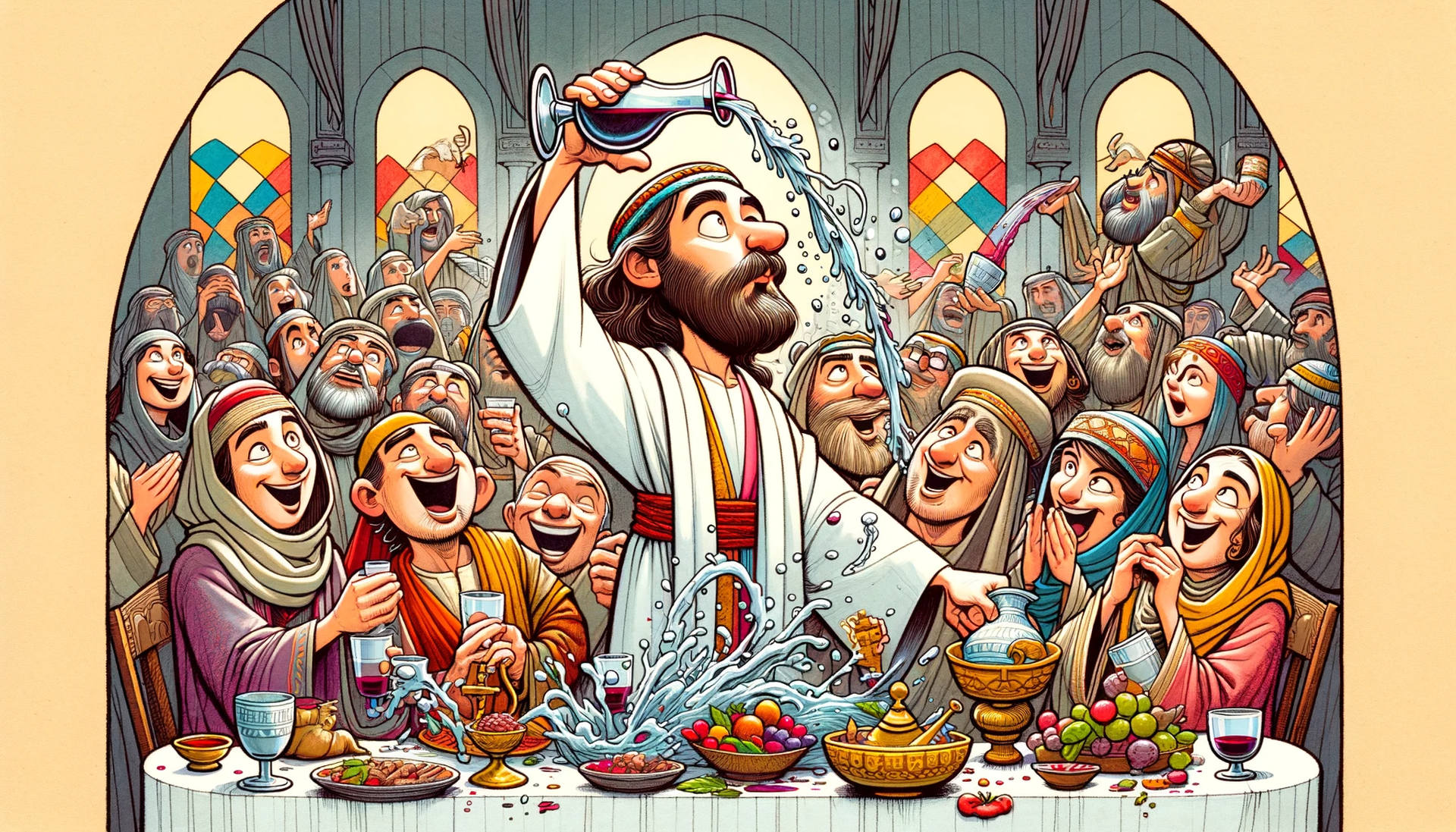
A Social Solvent: Wine’s Lubricating Touch
Yet, wine’s influence extended far beyond the consecrated altar. In the boisterous marketplace, it served as a social lubricant, facilitating commerce and forging bonds of fellowship. From humble taverns to lavish banquets, the clinking of cups marked the rhythm of daily life, fostering conviviality and easing the harsh realities of a world often steeped in conflict. Even wars, those grim tapestries of human folly, found respite in the shared chalice, soldiers momentarily laying down their blades to toast to a fragile peace amidst the din of battle.
The Song of the Vine: Wine’s Melodious Voice in Literature
From the parables of the Gospels to the lyrical verses of Virgil, wine found its voice in the poetic chronicles of the times. It became a metaphor for life’s intoxicating joys and crushing sorrows, its heady fragrance swirling through sonnets and epics. Roman bards like Ovid sang of Bacchus, the jovial god of wine, painting him as a symbol of untamed revelry and the divine madness that resides within the human spirit. In the austere pronouncements of Hebrew prophets, however, wine took on a darker hue, its excessive consumption a symbol of decadence and moral decay.
Echoing Through Time: Wine’s Historical Footprints
Beyond its immediate social and religious connotations, wine served as a silent witness to the grand march of history. The trade routes it opened, the treaties it sealed, the empires it both sustained and toppled – all etched in the delicate skin of the grape. The amphorae carried across the Mediterranean whispered tales of distant lands while the remnants of abandoned vineyards spoke of empires risen and fallen. In this way, wine became a tangible thread connecting eras, its ancient tang a whisper of forgotten laughter and echoing battles.
What does “The Marriage at Cana” say about the wedding in Cana?
The Marriage at Cana, 1596-1597, by Maarten de Vos, is a painting that depicts the biblical event told in John 2:1-11. The main message of marriage at Cana is one of hospitality, abundance, and joy. In this story, Jesus and his disciples are invited to a wedding feast in Cana, where they witness Jesus perform His first miracle: he turns water into wine. This event exemplifies how God provides for us even when we don’t know what we need or have faith to ask for it.
The Intoxicating Refresh
This is what we at Encyclopedia Wines understand: Every drop of wine is an epic. The artifacts and stories about wine are the biggest reason why this saga has endured for thousands of years; the art of growing grapes, tending vineyards, and achieving the perfect blend is only part of it. Wine is not just a process; it is an art form. It is a dance with nature that brings us closer to joys, sorrows and the essence of life. But!
The Divine Mixologist: Turning H2O into Merlot
The wedding at Cana – where Jesus famously turned water into wine, proving once and for all that he was the ultimate party guest. You’ve got to wonder, was this the divine answer to an open bar? Imagine the scene: guests whispering, “The wine’s run out,” and Jesus casually saying, “Hold my halo.” It’s like the first recorded instance of, “But wait, there’s more!” in history. And let’s not forget, this was his first public miracle. Talk about setting the bar high for party tricks. Next time you’re at a wedding, try topping that with a bouquet toss.
Sacred Spirits: The Holy Happy Hour
In the realm of religious rituals, wine wasn’t just a drink; it was the original subscription to divine Netflix – full of symbolism, drama, and a hint of transubstantiation. The Last Supper could be seen as the first wine-tasting event, where Jesus essentially said, “This wine is my blood,” and everyone just nodded and sipped. No wonder people were lining up to join the church. It’s like, “Come for the salvation, stay for the merlot.” And let’s not forget the Passover meal – where a sip of wine was the equivalent of a spiritual time machine, connecting past and present faster than a DeLorean.
Booze and Brotherhood: The Ancient Social Network
In the bustling marketplaces and taverns, wine was the original social media – without the need for likes, shares, or awkward friend requests. It was the glue that held society together, one goblet at a time. Imagine the scene: Roman soldiers putting down their swords to clink cups and say, “To peace, or at least until we invade the next village.” In that times wine was the ultimate peacemaker, proving that sometimes all you need to solve world problems is a good vintage and a couple of drinking buddies.
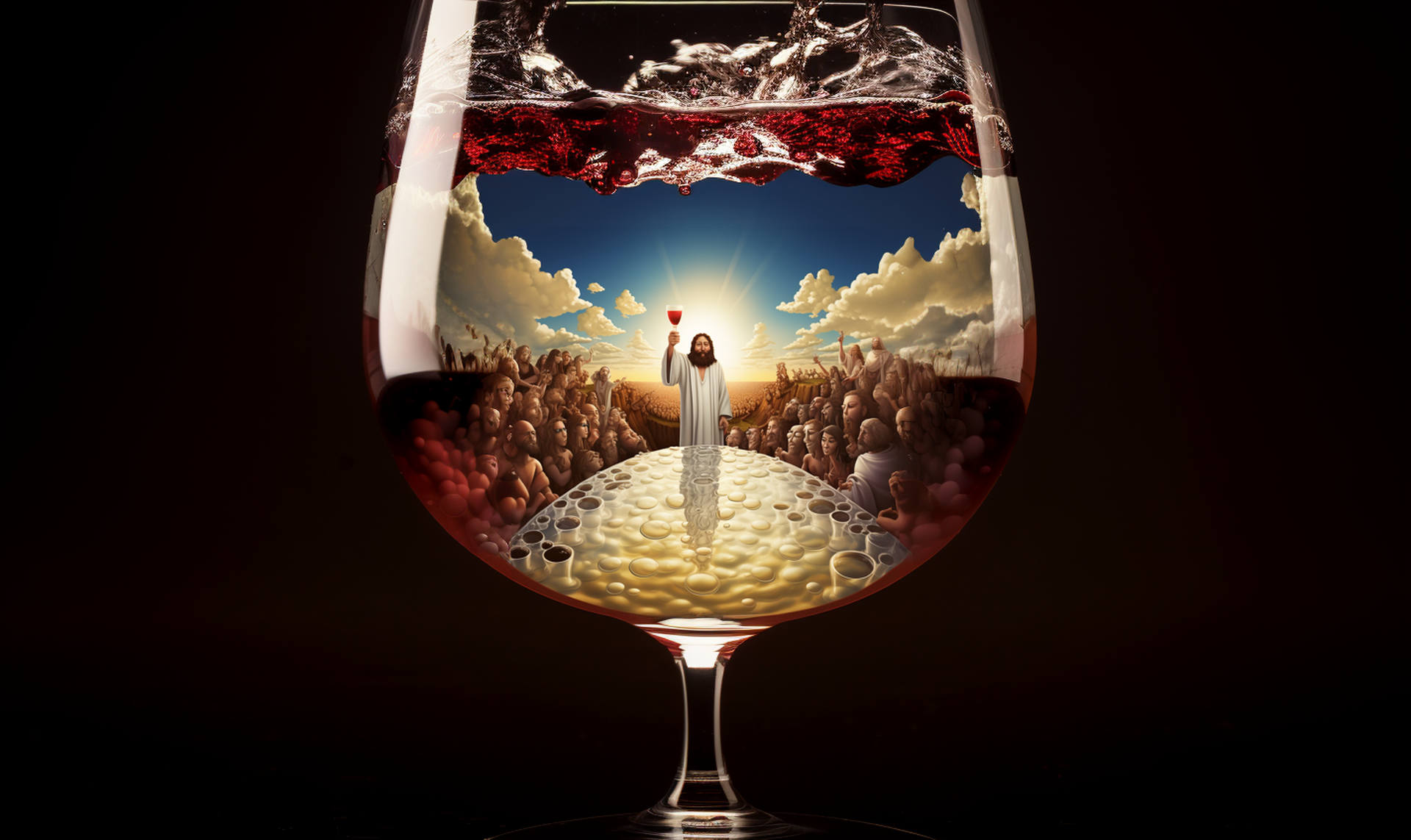
Drunken Poets Society: The Grapevine of Literature
In literature, wine is the muse that never demanded royalties. Poets and writers used it as a metaphor for just about everything – joy, sorrow, the fleeting nature of life. It’s like wine was the original emoji, conveying complex emotions without the need for words. And let’s not forget the Roman bards, who probably thought, “Why write about war and politics when you can sing about Bacchus and his vineyard shenanigans?” It’s the ancient equivalent of choosing cat videos over the evening news.
Vineyard Voyages: The Grape’s Historical Journey
In Jesus’ age, wine wasn’t just a drink; it was a history teacher in a bottle. Every amphora was like a time capsule, carrying stories of trade routes, empires, and the occasional vineyard gossip. It’s like each grape was whispering, “I’ve seen things, I’ve been places.” The remnants of ancient vineyards were like the Facebook pages of fallen empires – a glimpse into what was once great, now just a collection of nostalgic ruins and vintage memories.
So, The Wedding in Kana is a nexus of stories, interpretations, and meanings. It can be interpreted as a celebration of the non-linear, the non-hierarchical. The transformation of water into wine becomes a metaphor for the infinite possibilities of interpretation, for the myriad ways in which we can connect and understand this event.
As you know wines are produced miraculously and with a passion that discusses the essence of the human condition. From the strong tradition of Cabernet Sauvignon to the metaphysical musings of Merlot, we are not just tasters; we wine lovers are thinkers, explorers, and dreamers. So, let’s raise a toast to unravel the mysteries.
As we raise our glasses, let us remember the story of Cana and all that it symbolises. Let us embrace the approach to thinking and learning and open our minds to a broader, freer perspective. Let us recognise the power of narrative, the joy of discovery.
Salud to the stories yet to be told and the lessons yet to be learned. Salud to that! 🍷✨📖
Umut,
– Encyclopedia Wines Team 🍷🥂✨
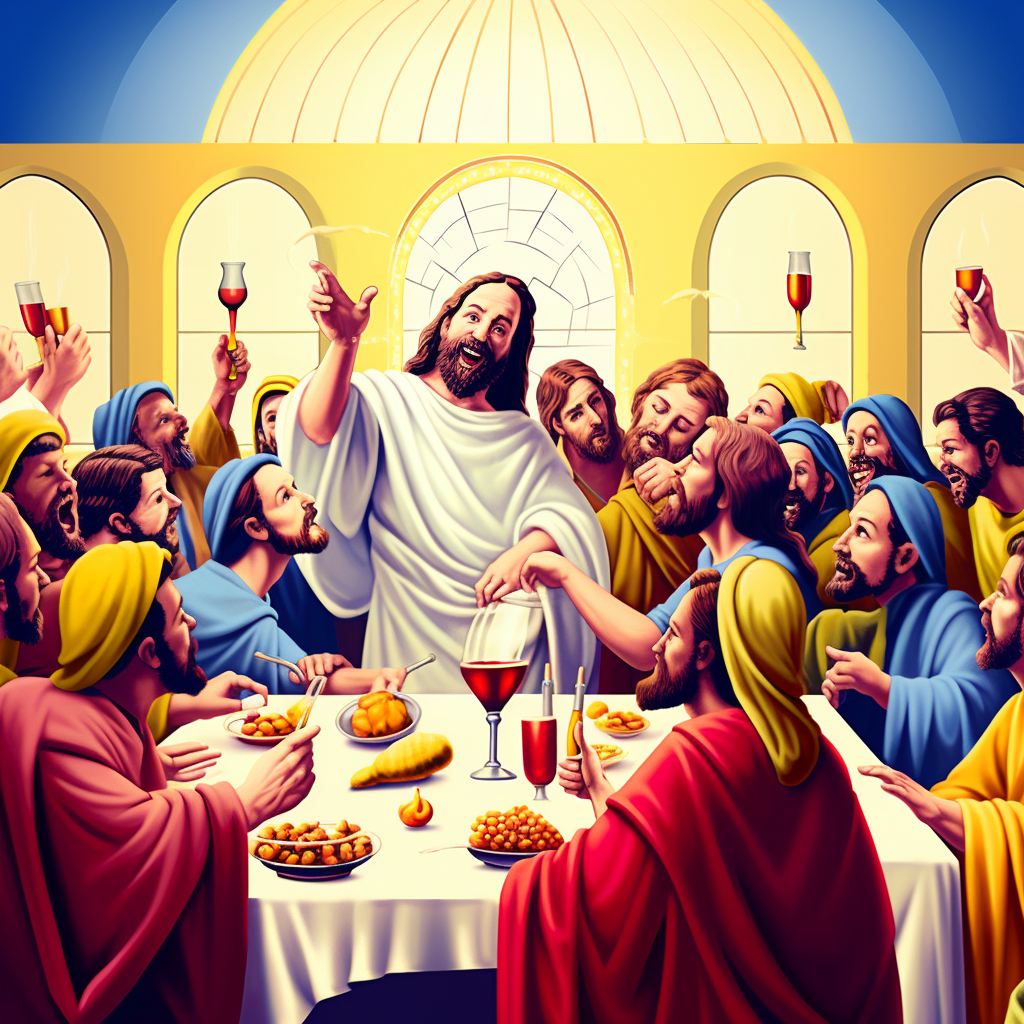
FAQ – About “The Marriage at Cana” by the sde of wine symbolism
Jesus turns water into wine at his own wedding?
Indeed, as stated in the Bible, Jesus performed the miraculous act of transforming water into wine during his own wedding. The incident is narrated in the biblical passage John 2:1-11 and is commonly known as “The Wedding at Cana” or “The First Miracle of Jesus.” During the wedding ceremony, Mary, Jesus’s mother, saw insufficient wine available for the guests. Jesus promptly responded that His appointed hour had not yet arrived, yet,
He continued to carry out the miracle. He commanded the attendants to fill six stone jars with water, which He subsequently transformed into exquisite wine, greatly pleasing everyone present. This episode illustrates the omnipotence of God over natural forces and showcases His benevolence and concern for all persons in His presence. If you find yourself in a difficult situation and require additional wine bottles for your wedding, recall the account of Jesus transforming water into wine – it could prove to be useful!
Why did Jesus turn water into wine at Cana?” you may find “Historical Context of Wine in Biblical Times” particularly enlightening.
Is Cana still in existence?
The Catholic church that commemorates this miracle is a renowned Christian pilgrimage site. Additionally, numerous couples select Cana as the venue to renew their wedding vows. Cana is located in modern-day Israel near Nazareth and the Sea of Galilee. Its name has an interesting origin; some scholars believe it derives from the Hebrew root for “reed” – qaneh – which was once abundant in this area. Today, Cana is a bustling village with a vibrant life that pays homage to its historic roots as the home of Jesus’ first miracle.
At Encyclopedia Wines, we’re passionate about this story from John 2 – especially the part where Jesus turned water into wine! We believe it speaks to the transformative potential of wine: its ability to transform any occasion into something special; its capacity to bring people together; its timelessness; its unique flavors and aromas; and so much more. To us, wine is a reminder of the beauty of life, and a celebration of all that’s wonderful. We invite you to join in the celebration as we explore the world of wines together!
Sources
- The Holy Bible, John 2:1-11 – The primary source for the story of Jesus turning water into wine at the wedding in Cana. Link
- “The Wedding Feast at Cana” by Maarten de Vos (1596-1597) – An artistic interpretation of the event. Link
- “Paolo Veronese: The Wedding at Cana” – Analysis of Paolo Veronese’s painting of the same event. Britannica
- “The Wedding at Cana” – An article discussing the significance of the event in Christian theology. Link
- “The Marriage at Cana of Galilee” is Google Arts & Culture’s feature on the painting. Link
- “Historical Context of Wine in Biblical Times” – An article discussing the role and symbolism of wine in biblical times. Link
- “The Miracle of Cana: Understanding Jesus’ First Miracle” – A theological interpretation and discussion of the miracle at Cana. Link
- “Wine in the Ancient World” – An academic article discussing the use and significance of wine in ancient cultures, including biblical times. Link
- “The Significance of Jesus’ Miracle at Cana” – A theological analysis of the miracle and its implications. Link
- “Cana Today: Exploring the Site of Jesus’ First Miracle” – An article exploring the modern-day location of Cana and its historical significance. Link
Keywords: communion, Jesus, miracle, water into wine, God's promise, provide for all, carefully curated selection of wines, feel close to Jesus, raise a glass to His everlasting grace and provision. Marriage at Cana, Maarten de Vos, John 2:1-11, hospitality, abundance, joy, Jesus' first miracle, water into wine, God provides, moments of joy and celebration, bright colors, Cana Painting, Maarten de Vos, Jesus, Water Into Wine Miracle, Joy & Celebration, Faith & Trust, Love & Grace, Perfect Bottle of Wine, Love & Cheer, Bible, Wedding at Cana, First Miracle of Jesus, Mary, Jesus' mother, stone jars with water, high-quality wine.

